JARS v58n4 - Hybrid Vigor in Vireya Rhododendrons
Hybrid Vigor in Vireya Rhododendrons
Sherla Bertelmann
Keaau, Hawaii
At a recent Hawaii Chapter meeting a plant of the vireya rhododendron 'Lazarus' was up for auction. I made the comment that 'Lazarus' was not an easy plant to grow and, therefore, not a beginner's plant. Fellow member Dennis Rees asked me, "Why?"
Well, that question came home with me. A good plant is one that is easy to root, repeats blooms, is a vigorous grower, transplants with barely a skipped beat, and needs little fussing over. It adapts to various conditions such as shade and sun, grows in upper and lower elevations, handles stressing changes such as drought and rain, grows in the ground or can stay in pots. Okay. But why are some "good" plants and others not? We've heard the term "hybrid vigor" as a reason, but what is "hybrid vigor"?
One definition of hybrid vigor I found was: the increase in growth, intelligence, yield or other characters in hybrids over those of the parents.
Now we are talking about genes. So, I went to the Internet and did a search for "hybrid vigor" and came up with an article with a scientific explanation. The article, "Discovering A Possible Explanation for Hybrid Vigor" by Joseph Blumberg from UniSci, Daily University Science News, states:
Agricultural breeders have long observed that when plants or animals from different strains are interbred, the offspring tend to be stronger, healthier or generally more fit than either of their parents, although no one knew why this occurred. Now plant geneticists investigating the maize (corn) genome (genes) at Rutgers' Waksman Institute of Microbiology have discovered a possible explanation for this phenomenon, known as heterosis or hybrid vigor.
The Rutgers findings, presented by research associate Huihua Fu and Prof. Hugo K. Dooner…have important implications for the understanding of plant genetics as well as applications for improving agriculture.
The scientists began by taking a region of the maize genome and sequencing it, mapping the way the genetic material is laid out. To their surprise, when they sequenced the same region from another strain of maize, "everything was different", Dooner reported.
Some of the genes from the first strain seemed to be missing from the second, yet the characteristics the genes controlled were still being expressed: that is, their effects were still being observed in the plants themselves. The scientists concluded that closely related genes that affect the plant in similar ways must be located elsewhere in the maize's' genetic material...
"This is an important finding," said Dooner. "If you have two members of a gene family but expressing themselves in two different tissues, then a crossbred plant could contain both of the genes and may therefore be better off." This is particularly true under stressful environmental conditions where the offspring would be better equipped to respond to stress. “That may well be their real basis for hybrid vigor,” said Dooner.
Conversely, Fu and Dooner found that inbreeding these hybrids - that is, breeding an individual with others from the same stock - resulted in a reduced number of gene family members. "Ultimately, this yields inbreeding depression, which is the other side of the coin, where you have less healthy offspring," said Dooner.
Agricultural breeders have historically developed most of their hybrids through trial and error processes, but they have gained an understanding of what it takes to create vigorous lines. With the revolution in genomics molecular biologists have begun to team up with the breeders. They are looking at the DNA trying to predict the performance of hybrids as they follow easily observed genes or molecular markers through generations. According to Dooner, "Maybe there are gene families that should be followed together. It could be a pretty major undertaking but with new sophisticated analyses looking at tens of thousands of genes at a time, it may be possible."
Okay, I now had a definition and a scientific explanation. It helped me understand why species are much more environmentally specific in their needs. That's like the purebreds without an outside influence. Cross two species and you get your first hybrid…but what after that?
My thoughts turned to a number of 'Harry Wu' (open pollinated) seedlings that are starting to bloom. Perhaps I can look at this group as compared to the one parent we know, 'Harry Wu'. Starting with 'Harry Wu', which is Rhododendron zoelleri x R. leucogigas , two different species, an outside pollen factor, probably with the help of a hummingbird moth, produced a large seed pod on 'Harry Wu' which was harvested. Here are the results.
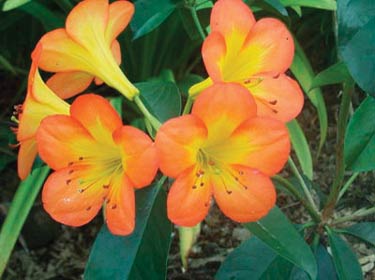
|
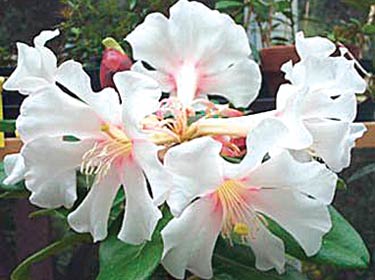
|
|
|
Fig. 1.
R. zoelleri
.
Photo by Sherla Bertelmann |
Fig. 2.
R. leucogigas
'Hunstein's Secret'.
Photo by Bill Moyles |
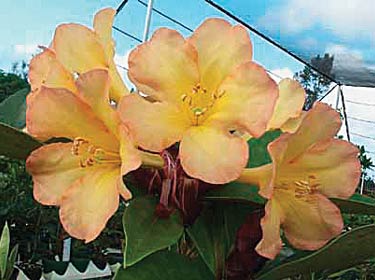
|
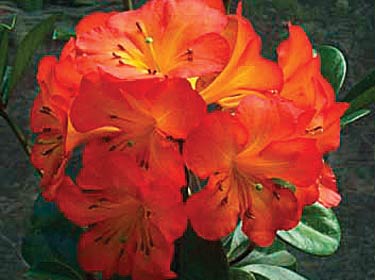
|
|
|
Figure 3. 'Harry Wu'.
Photo by Sherla Bertelmann |
Figure 4. A 'Harry Wu' seedling.
Photo by Sherla Bertelmann |
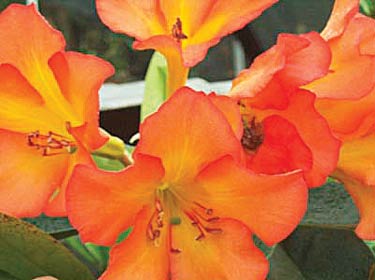
|
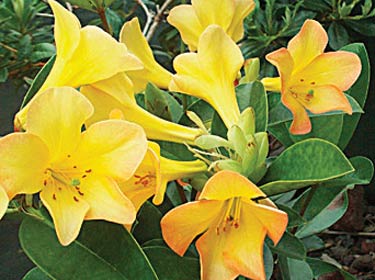
|
|
|
Figure 5. A 'Harry Wu' seedling.
Photo by Sherla Bertelmann |
Figure 6. A 'Harry Wu' seedling.
Photo by Sherla Bertelmann |
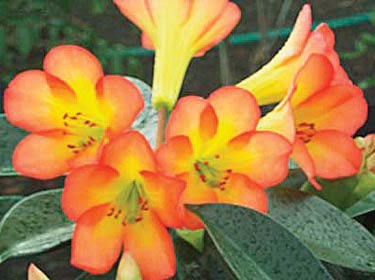
|
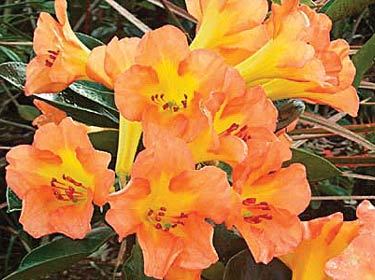
|
|
|
Figure 7. A 'Harry Wu' seedling.
Photo by Sherla Bertelmann |
Figure 8. A 'Harry Wu' seedling.
Photo by Sherla Bertelmann |
We start with the parents of 'Harry Wu', R. zoelleri in Figure 1 and R. leucogigas in Figure 2. Figure 3 shows 'Harry Wu', a result of this cross and the seed parent of our crosses, known for its extra large flowers, large leaves, fantastic repeat blooming, ease of growing and sturdy overall growing.
Figure 4 shows a 'Harry Wu' seedling with deep red-orange large flowers with deep yellow centers in a in a full domed shape. There is a characteristic in this truss I have seen in other R. zoelleri plants, that is, the joining together of two or three flower stems in the center of the truss that causes the flowers to stand up. That's what gives it a full domed shape. Leaves are not as big as those of 'Harry Wu' nor is the clone as leggy. It tends to be fuller with shorter internodes.
Figure 5 shows a seedling with very large flowers of a rich red-orange with yellow center and ruffled edges. The color on this deepens and the flowers get larger with age. The truss shape is similar to that of 'Harry Wu'. It does not have joined stems in the center of the truss, but the flowers are so large that, like 'Harry Wu', it forms a round upright truss. Leaves are not as big as those of 'Harry Wu' nor is it as leggy. It tends to be bushy with shorter inter-nodes.
Figure 6 shows a seedling with medium sized yellow flowers with a flush of orange on the edge. Flowers are firm and more tubular than those of 'Harry Wu'. Again the overall growth habit is better than that of 'Harry Wu', naturally bushy, smaller leaves and shorter inter-nodes.
Figure 7 shows a seedling with medium large tubular flowers of firm substance with R. zoelleri coloring of rich orange and yellow. The green stamens stand out from the centers. It has erect growth habit, smaller leaves and is bushier than 'Harry Wu'.
Figure 8 shows a seedling with large bronzy orange ruffled flowers with deep yellow throats. The growth habit on this one is like its siblings - erect, smaller leaves than 'Harry Wu', bushier, shorter inter-nodes.
One of the characteristics these seedlings may have picked up is the mass blooming habit of 'Harry Wu'. They were covered with buds at the time of writing this article. A couple have the flower size of 'Harry Wu', but other than that the difference between these seedlings and their parent, 'Harry Wu', comes down to two things. The first is the intensity of color and the second is their better growth habit, referring to their shorter inter-nodes and bushiness. Only time will show if they also turn out to be just as good or better bloomers than 'Harry Wu'.
So, what makes one vireya an easy, beginner's plant versus one considered "touchy" or "harder to grow"? Hybrid vigor. The easy beginner's plant got all the good genes while the harder to grow one may have a few "not so good" genes.
I hope this answers Dennis's original question to me: "Why? What makes one plant better than another?" "Hybrid vigor, Dennis, hybrid vigor."
Sherla Bertelmann is president of the Hawaii Chapter.
